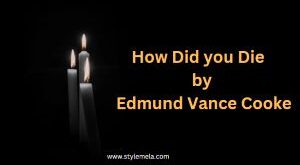The Raven as a Gothic Poem
Introduction
Edgar Allan Poe’s The Raven is one of the most famous Gothic poems in literature. It tells the story of a man who is haunted by the loss of his love, Lenore, and the mysterious visit of a talking raven. Full of dark themes, eerie atmosphere, and supernatural elements, The Raven is a perfect example of Gothic poetry. In this article, we’ll explore why The Raven is considered a Gothic poem and the elements that make it stand out.
Gothic Elements in The Raven
The Raven is filled with the key features of Gothic poetry. These include:
- A dark and mysterious setting: The poem takes place in a dimly lit room at midnight. The gloomy, isolated atmosphere is typical of Gothic settings.
- Supernatural elements: The talking raven itself is a supernatural figure. In Gothic poetry, creatures like ghosts, ravens, and other strange beings often appear.
- Emotional intensity: The narrator is grieving the loss of his beloved Lenore, and his emotions of sorrow, despair, and fear are intense throughout the poem.
- Themes of death and the afterlife: The poem focuses on the narrator’s obsession with death, especially wondering whether he will see Lenore again in the afterlife.

The Raven’s Atmosphere
One of the most important features of The Raven is its atmosphere. Poe creates a mood of suspense, mystery, and fear using descriptive language. The setting is dark, with shadows, the night, and the cold, all creating a sense of isolation. The narrator is alone, mourning the death of Lenore, and the sudden appearance of the raven adds to the tension. This atmosphere is common in Gothic poetry, where the environment often reflects the emotions of the characters.
The Raven as a Symbol
In Gothic poems, symbols are often used to deepen the meaning of the story. In The Raven, the raven itself is a powerful symbol. It represents death, despair, and the narrator’s inability to move on from his grief. The raven repeats the word “Nevermore,” which makes the narrator believe that he is doomed to never escape his sorrow or find peace.
Themes of Madness and Obsession
Another important Gothic element in The Raven is the theme of madness. As the poem progresses, the narrator becomes more and more obsessed with the raven’s message. He starts asking the bird questions about life, death, and the afterlife, even though he knows it can only say “Nevermore.” His growing madness and despair are classic themes in Gothic poetry, where characters often lose their grip on reality due to intense emotions.
The Supernatural in The Raven
The appearance of the raven is not just unusual—it’s supernatural. The fact that the bird can talk adds an eerie, otherworldly quality to the poem. In Gothic poetry, the supernatural often plays a key role in adding mystery and fear. The narrator even begins to wonder if the raven is a messenger from the afterlife, adding to the poem’s focus on death and the unknown.
Conclusion
The Raven by Edgar Allan Poe is a classic Gothic poem because of its dark themes, eerie setting, and supernatural elements. It explores deep emotions like grief, despair, and madness, all while keeping readers on edge with its suspenseful atmosphere. Poe’s masterful use of Gothic elements makes The Raven a timeless work that continues to captivate readers with its haunting beauty.
Read More:
10 of the Greatest Poems of All Time
10 Best American Poets and Their Timeless Contributions
